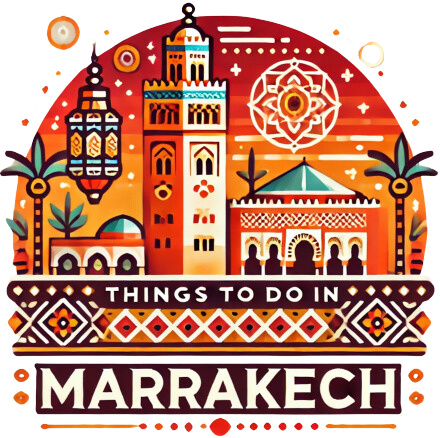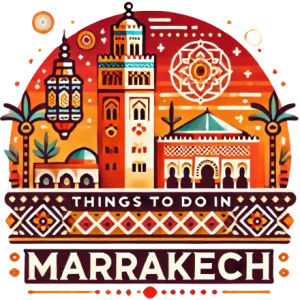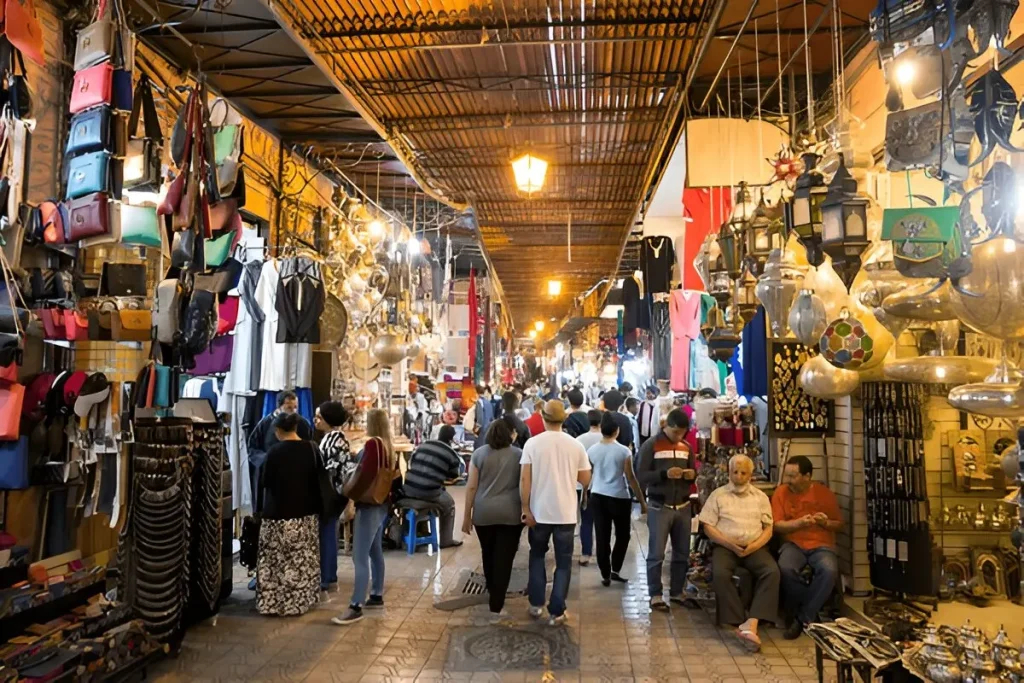Souks in Marrakech are more than just markets—they’re the pulse of the medina. From handwoven rugs to aromatic spices and lanterns made by skilled hands, souks Marrakech offer a shopping experience that blends tradition, culture, and craftsmanship. If you’re planning to explore the heart of the city, this guide will walk you through the best souks to visit, what to expect, and how to make the most of every step.
Table of Contents
What Are the Souks in Marrakech?
In Morocco, the word “souk” means marketplace. But in Marrakech, souks stretch beyond a single plaza or street. They weave through the old medina in a living maze. The souks Marrakech are a collection of covered alleyways and courtyards lined with shops selling everything from handmade slippers to carved wood and copper lamps.
Unlike modern shopping centers, these markets operate on tradition. Crafts are passed from one generation to the next, and many vendors are artisans themselves. What makes the souks so special is their ability to blend the ancient and the everyday into one experience.
The History of Marrakech’s Souks
Souks have existed in Marrakech since its founding in the 11th century. Located along key caravan routes, the city became a central trading post for merchants from Sub-Saharan Africa, Europe, and the Middle East. Traders brought gold, salt, fabrics, and spices—items that are still part of the market culture today.
The souks were traditionally organized by trade. For example, the dyers had their area, the blacksmiths theirs, and so on. This system still exists, although today’s souks are more diverse and adapted to visitors. But the soul remains—the crafts, the haggling, the interaction between maker and buyer.
Top Souks to Visit in Marrakech
1. Souk Semmarine
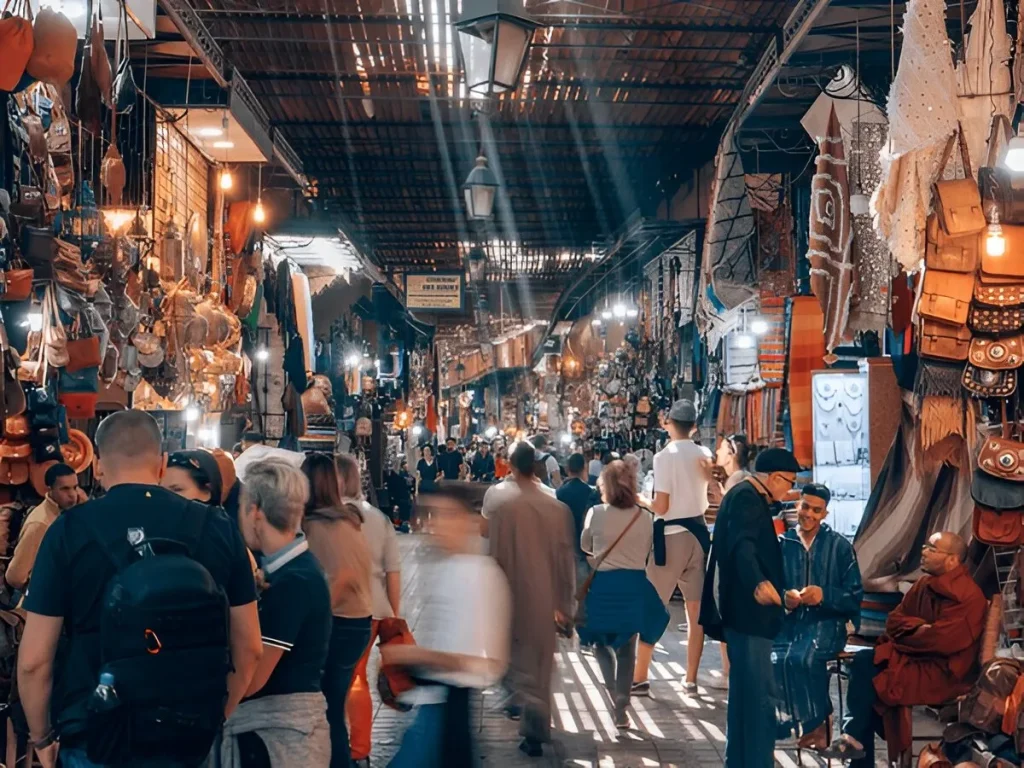
Souk Semmarine is the main artery of the medina’s market and usually the first place most visitors walk through when they enter the souks Marrakech. It starts just off the famous Jemaa el-Fnaa square and stretches deep into the heart of the medina. This area is bright, wide, and full of movement. Stalls are packed with colorful textiles, silver jewelry, embroidered caftans, and handmade leather bags. It’s one of the most tourist-friendly sections of the Marrakech traditional market, and you’ll notice that many shopkeepers here speak English, French, and sometimes even Spanish.
Even though it’s popular with tourists, you can still find authentic Moroccan souvenirs if you know where to look. Step away from the main path and take a turn into one of the quieter alleys—you’ll discover hidden gems like small family-run workshops where artisans are hand-stitching belts, weaving fabrics, or crafting custom sandals. If you’re wondering what to buy in Marrakech souks, this is a great place to start. It gives you a feel for the energy of the market while offering a safe space to practice your bargaining skills. You’ll leave with more than just items—you’ll take a piece of Marrakech’s culture with you.
2. Souk El Attarine
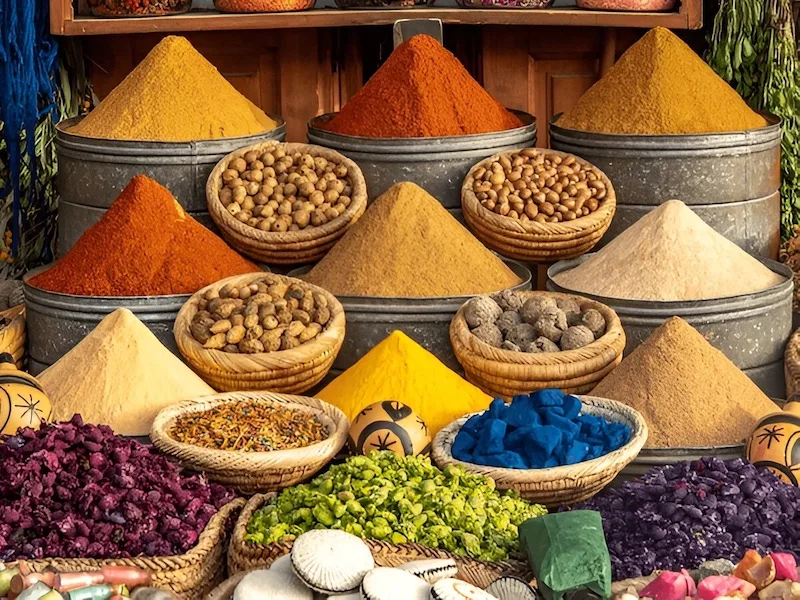
Known as the spice souk, this part of the souks Marrakech is rich in both color and aroma. It’s one of the most sensory parts of the medina, where every corner bursts with bold displays of turmeric, saffron threads, dried rosebuds, cinnamon sticks, and piles of Ras el Hanout. These spices aren’t just for show—they’re the backbone of Moroccan cuisine. You’ll often see the spices arranged in colorful pyramids that catch the eye of every passerby. The scent in the air changes with every step you take.
Vendors here are passionate about what they sell. They’ll happily invite you to smell different blends and explain the ingredients and how they’re used in tagines, couscous, or traditional Moroccan tea. If you’re curious about what to buy in Marrakech souks and want something that truly brings home the flavor of the city, this is the place. Spice shopping isn’t just about buying—it’s an experience. Whether you’re looking for gifts, ingredients for your kitchen, or just want to understand more about Moroccan food culture, this spice market is a must. Don’t be surprised if you end up spending more time here than you planned.
3. Souk Cherratine
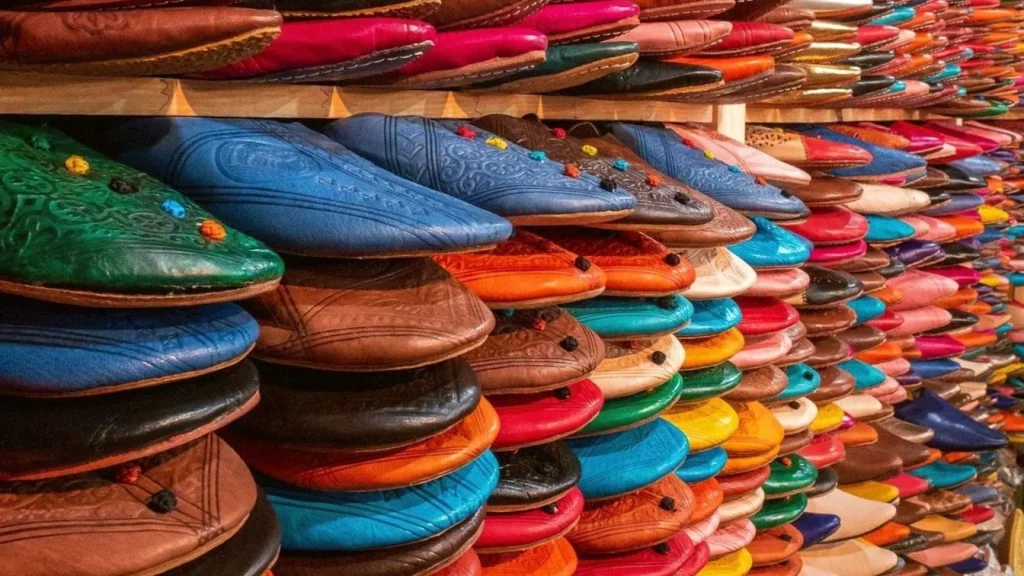
Leather is a big deal in Marrakech, and Souk Cherratine is the place where that reputation really comes to life. Tucked away from the busiest lanes of the souks Marrakech, this area is entirely focused on leather goods. As you walk through, you’ll find rows of shops displaying everything from handmade belts and structured handbags to vibrant leather poufs, wallets, journals, and traditional Moroccan slippers called babouches. The smell of tanned leather fills the air—a sign that you’re in one of the city’s oldest and most respected leather markets.
What makes Souk Cherratine special is not just the variety, but the chance to see genuine Moroccan craftsmanship up close. Many of the stalls are run by families who’ve worked with leather for generations. You’ll often spot artisans cutting, stitching, or dyeing leather right behind their displays. Prices here can vary widely depending on the material and detailing, so it’s smart to take your time and compare. If you’re wondering where to shop in Marrakech for authentic leather goods, this is one of the best places. It’s ideal for those seeking high-quality, handmade pieces that reflect the true spirit of the Marrakech traditional market.
4. Souk Zrabia
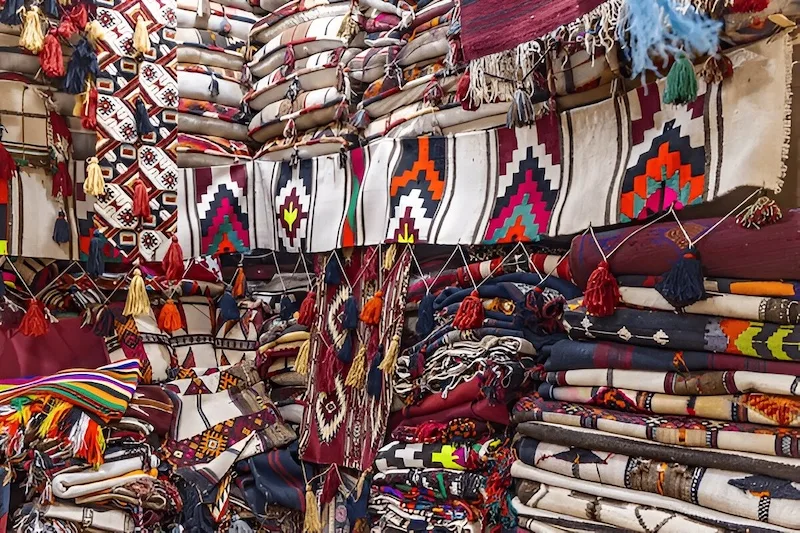
This market specializes in rugs, and it’s one of the most captivating corners of the souks Marrakech. Whether you’re after a vintage Berber carpet or a newly woven kilim, you’ll find an impressive range of styles and sizes here. The shops are stacked floor to ceiling with richly patterned textiles—Beni Ourain rugs with their soft wool and geometric lines, bold-colored Azilal pieces, flat-woven kilims from the Middle Atlas, and intricately knotted tribal carpets that reflect generations of tradition. Each rug is more than just a floor covering—it tells a story of a region, a tribe, and sometimes even the personal experiences of the woman who wove it.
This part of the Marrakech traditional market feels calmer than other areas, which makes it a great space to take your time. Shop owners often offer tea while you browse and will happily unroll rug after rug without rushing you. If you’re wondering what to buy in Marrakech souks that truly lasts and holds meaning, a handmade Moroccan rug is at the top of the list. Don’t hesitate to ask about the symbols, dyes, or materials used. A sincere vendor will take pride in sharing the rug’s background with you—and that personal connection is what makes the experience unforgettable.
5. Rahba Kedima
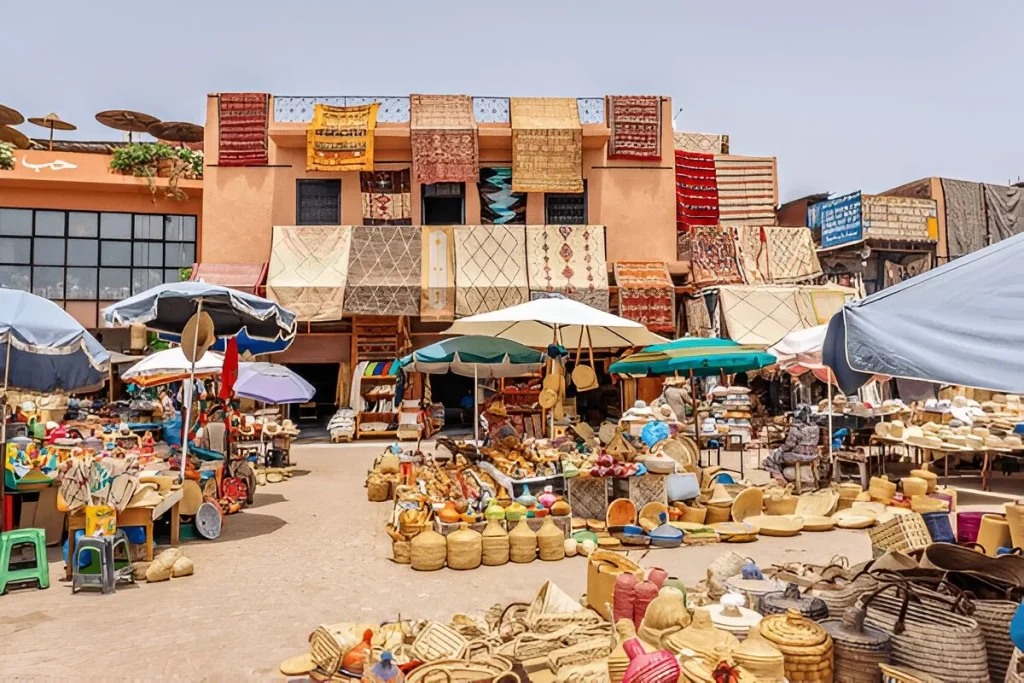
This square sits right at the heart of the spice district within the souks Marrakech and offers a different rhythm from the narrower, busier lanes around it. Known as Rahba Kedima, it’s an open-air market space where sunlight filters through and the pace feels a little more relaxed. It’s a great spot to pause, people-watch, and take in the medina’s vibrant energy without feeling overwhelmed. While spices still play a big role here, the market goes beyond just herbs and seasonings.
You’ll come across woven baskets in every size and color, handmade using palm fronds and perfect for shopping or storage back home. Many stalls also sell traditional Moroccan beauty products—things like black soap, argan oil, rose water, and ghassoul clay. These items are staples in local skincare routines and make for excellent souvenirs that are easy to pack. If you’re exploring the Marrakech traditional market and want to find a place to breathe, browse, and maybe even sip on a fresh orange juice from a nearby stand, Rahba Kedima delivers. For travelers looking for what to buy in Marrakech souks that blends wellness and culture, this square is a must-visit.
6. Souk Haddadine
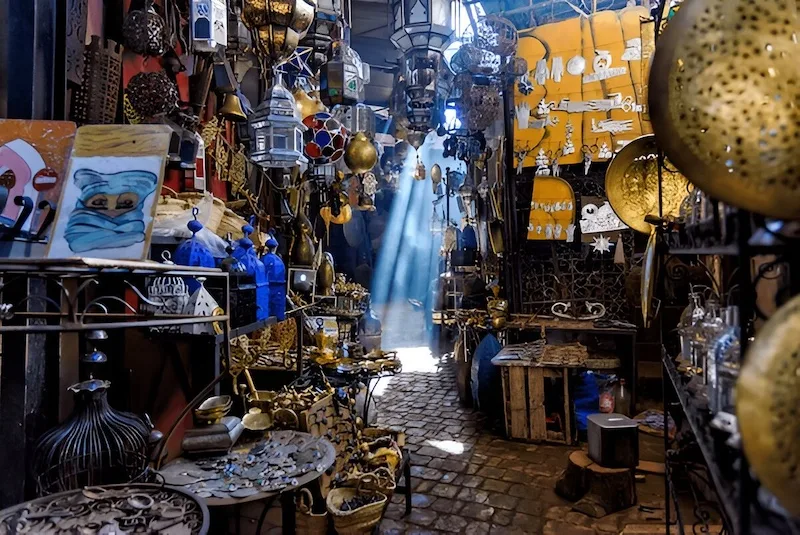
This is the blacksmiths’ quarter, one of the most traditional and raw sections of the souks Marrakech. As you walk through, the sounds change—from the chatter of merchants to the steady rhythm of hammers striking metal. Sparks fly from small open forges, and the smell of hot iron fills the air. It’s here that artisans shape brass, copper, and iron into intricate lamps, decorative locks, curtain hooks, and custom furniture fittings. Every item you see is the result of hands-on work, usually done right on-site in open workshops that line the alley.
Although it doesn’t get as much attention as the more colorful parts of the Marrakech traditional market, this area is a treasure trove for anyone who appreciates craftsmanship. It’s also one of the best spots to see artisans in action, using age-old techniques that haven’t changed much in generations. If you’re looking for authentic Moroccan souvenirs that feel grounded in the city’s working-class roots, this is where to shop in Marrakech. The energy is different here—grittier, more honest, and full of stories forged in fire and metal.
Moroccan crafts, especially rugs and leather goods, are internationally recognized for their quality and cultural value. According to UNESCO’s Intangible Cultural Heritage listings, Morocco’s artisanal traditions play a vital role in preserving identity and heritage through handmade practices.
Popular Products You’ll Find in the Souks
- Rugs & Carpets: Berber, Beni Ourain, kilims, and vintage pieces
- Spices & Herbs: Ras el Hanout, saffron, cumin, dried mint, and rose petals
- Lanterns: Brass and colored glass in a variety of shapes
- Leather Goods: Bags, belts, jackets, poufs, and babouches
- Textiles: Scarves, hand-embroidered pillowcases, caftans
- Woodwork: Thuya wood boxes, chessboards, trays, and furniture
- Cosmetics: Argan oil, kohl, rose water, and ghassoul clay
- Ceramics: Zellij-inspired patterns and hand-painted plates
How to Bargain in the Souks Like a Local
Bargaining is expected. Vendors often start high—sometimes double or triple the local price. Start at 40-50% of the asking price and slowly work up. Be friendly and respectful, and don’t show too much interest too soon. If you’re not happy, walk away. Often, the seller will call you back with a better deal.
Pro tip: Always bargain with a smile. It keeps the interaction positive and often gets better results.
Common Tourist Mistakes to Avoid
- Skipping small alleys: Don’t just stick to the main souks. The best deals and most authentic goods are often in side streets.
- Buying without comparing: See multiple shops before making a decision, especially for rugs and lanterns.
- Falling for fixed prices: Even if a sign says “fixed price,” there’s often wiggle room.
- Not checking materials: Be cautious with items labeled as “100% cashmere” or “pure silver” without proof.
How to Know If It’s Handmade or Mass-Produced
Handmade items usually have slight imperfections—irregular stitches, uneven finishes, or variations in color. That’s a good thing. Mass-produced souvenirs tend to be too perfect and often come from overseas. Ask questions: Who made it? Where? If the seller can’t answer, it’s probably not handmade.
When to Visit the Souks Marrakech
The souks are open daily, typically from 9:30 AM to 8:00 PM. Friday mornings can be quiet as many locals attend mosque. The best times to visit are:
- Morning: Less crowded, cooler weather
- Late afternoon: Good time for last-minute deals
Where to Eat Near the Souks
Shopping can be tiring, so plan a break. Here are some cafes near the medina where you can recharge:
- Café des Épices: Great views over Rahba Kedima and a solid Moroccan-French menu
- Nomad: Trendy, rooftop views, modern Moroccan dishes
- Atay Café: Laid-back vibe, mint tea, and tasty couscous
Local Workshops Worth Visiting
If you’re serious about Moroccan crafts, visit workshops outside the medina. You’ll see artisans working on brass, wood, leather, and textiles. Some of them even offer short classes where you can try weaving or pottery yourself. These places are quieter, and you’ll gain a deeper appreciation of the work behind the products sold in the souks Marrakech.
Are the Souks Safe for Tourists?
Yes. The souks are generally very safe. Petty theft is rare. Still, keep your phone and wallet secure, especially in crowded areas. If someone offers directions or insists on helping, it’s okay to politely decline unless you’re lost and willing to tip.
Bringing Items Back Home
If you’re flying home, check with your airline on what you can bring. Most spices and packaged food are fine. Rugs can be shipped internationally, and many vendors handle it for you (just get a written receipt). Brass and ceramics can be heavy, so pack carefully or let the vendor arrange secure shipping.
Final Thoughts
There’s nothing quite like the souks Marrakech. Whether you’re looking for gifts, décor, or just a deeper understanding of Moroccan life, the souks deliver. They’re a place where history meets hustle, where craft is respected, and where your purchase means something. Take your time, trust your gut, and enjoy every step.
Want more tips on things to do in Marrakech? Explore our full activities guide here.
FAQ
What are the best souks to visit in Marrakech?
The most popular and accessible souks in Marrakech include Souk Semmarine, Souk El Attarine (the spice market), Souk Cherratine for leather, Souk Zrabia for carpets, and Rahba Kedima for beauty products and baskets. Each offers a different vibe and range of products, giving you a full experience of Marrakech’s traditional market culture.
What should I buy in the souks Marrakech?
Some of the most sought-after items include Moroccan spices, leather bags, Berber rugs, brass lanterns, ceramic bowls, and argan oil. These products reflect the local craftsmanship and make for meaningful souvenirs that last.
Is it okay to bargain in the Marrakech souks?
Yes, bargaining is expected and part of the culture in the souks Marrakech. Start at 50% of the asking price and negotiate with a smile. Shopkeepers respect polite negotiation and often enjoy the process as much as you do.
Are the Marrakech souks safe for tourists?
Generally, yes. The souks are safe to explore during the day. Keep an eye on your belongings, avoid following unofficial guides, and politely decline aggressive sellers. Most locals are friendly and helpful if approached respectfully.
When is the best time to visit the souks in Marrakech?
The souks are open daily, but mornings and late afternoons are ideal to avoid heat and large crowds. Spring and autumn offer the most comfortable weather for browsing and shopping.
